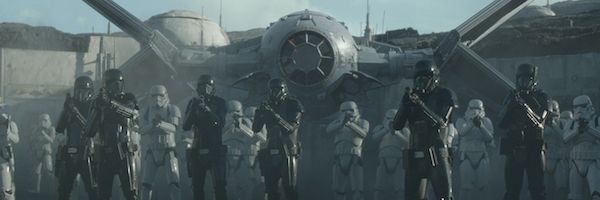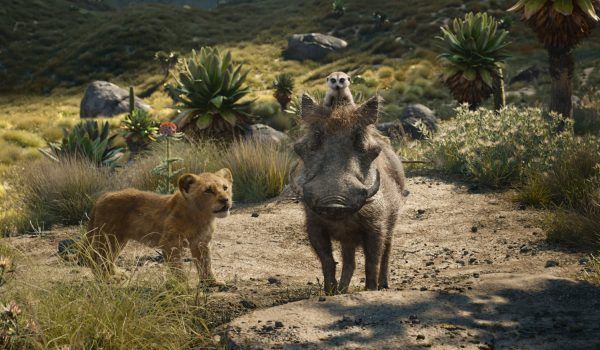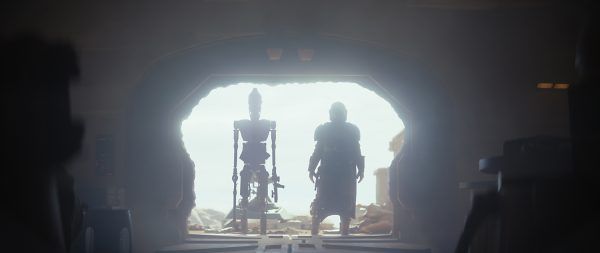Watching The Mandalorian, Disney+’s flagship series set that is set in the hardscrabble, post-Return of the Jedi galaxy, it was clear that something was going on. After all, this was the first live-action Star Wars series and, as such, had to have just as much oomph as any of the movies or animated series that came before it. Industrial Light & Magic, the visual effects company founded by Star Wars creator George Lucas nearly 45 years ago, has made great strides in terms of making technologically advanced (but still affordable) visual effects on the small screen, most notably for Lucas’ own The Young Indiana Jones Chronicles. But it was clear that ILM was up to something different with the new series. Just how different hadn’t been fully illuminated until this week’s episode of Disney Gallery: The Mandalorian, the compelling behind-the-scenes companion series (available now on Disney+).
This week’s episode (“Technology”) is all about how they pulled off The Mandalorian’s impressive location work – the alien planets and the derelict space stations that the masked bounty hunter visits on his journey. (Episode Six, “Visualization,” undoubtedly goes into the post-production effects that help bring everything to life.) Most of the episode centers around The Volume, a circular stage set up in downtown Los Angeles. The ceiling and walls of The Volume are covered in high-def LED panels that can simulate the topography of distant worlds with eerie accuracy. It is, true to the Star Wars series’ history with breaking new ground, pretty astounding stuff.
The idea to approach the production like this came from series creator Jon Favreau. Favreau had come from working on The Lion King, which employed VR camerawork to simulate real-life cinematography, and had used giant LED lights for certain sequences in The Jungle Book, noting that animating shadows on a real-life performer always looks dodgy. Initially the idea was to have the technology help with pre-visualization and the tracking of green screens along with the actors. But Favreau convened a “think tank” of effects artists and video technicians, including Richard Bluff and John Knoll to see if they could take the concept further.
What they came up with was this highly expressive, photorealistic video-lined stage that they dubbed The Volume. It was a 75-foot-diameter stage covered in thousands of LED panels. “The Mandalorian is the first production ever to use real-time rending and video wall in-camera set extensions and effects,” Favreau proudly proclaims. And he’s got a right to brag: It’s unlike anything that’s ever been attempted before, a synthesis of filmmaking prowess and videogame software that lends an unbelievable level of reality to each and every scene it’s utilized for.
Basically, how The Volume works is that there would be real-life sets in the foreground (say, a rock formation or part of a garage or hangar), sometimes with full-sized props like all or half of The Razorcrest, The Mandalorian’s signature spaceship. But beyond, just a few feet back, the video screens would take over – that’s where the rest of the space station would be (complete with smoking debris and sparks) or the sandy dune of Tattooine. Since the geometry of the set (and the background) was already loaded into the computer, it communicates with the camera so when the camera moves or the actor changes position, the telemetry is corrected and the view changes accordingly. It reacts, in real time, to keep the background images looking 100% perfect. Even the behind-the-scenes footage, which occasionally has a shutter (since those cameras aren’t connected to the system), looks absolutely astounding. It was used for more complex sequences, too, like our heroes journeying down the lava river at the end of the final episode (since there are panels on the ceiling, the sensation that they are underground, with light coming in from slats overhead, is maintained).
This new technology freed the entire team. Now The Mandalorian’s armor could be silvery and reflective, since the light from the environments would bounce off of him in real time. (The alternative, groaned Favreau, was that greenscreen would be used and then you’d have to paint the green out of the reflection and then sub in new reflection.) Additionally, his ship is made of a mirrored material, which also can interact with its environment since it’s all right there.
As is evidenced in this episode, both the actors and the directors were utterly impressed with the technology. Taika Waititi, who helmed that final episode (and also voiced the reformed murder droid IG-11) said, “One of the most exciting things I had the pleasure of working with on this was the LED Volume.” He described it as “a big room of TV screens.” “Sometimes, you’d walk into the Volume and you wouldn’t recognize where the screens were; it was that flawless,” Waititi said. Carl Weathers said that, “I found it as liberating as anything I’ve worked on.” He seemed genuinely pleased with being able to actually see what he was supposed to be looking at. And he said it helped, particularly in that sequence where they’re going down the lava river, because all four actors would have “four different concepts of what’s going on.” With the lava actually there, the actors were able to sync up beautifully. Giancarlo Esposito, who plays the villainous Moff Gideon, was also very enthusiastic. “I can look over my TIE Fighter and see the horizons,” Esposito said.
And, true to everything new in the Star Wars galaxy, the technology's origins begin (at least spiritually) with George Lucas himself. Bryce Dallas Howard, who directed one of the Season 1 episodes and who has known Lucas forever, said that it was Lucas who first imagined a setup like this. “One day, we’re going to be able to make these movies in our garage,” she remembers him saying. Producer Kathleen Kennedy says that the new technology is the next evolution of the digital set extensions that Lucas was so fond of on the prequels. “He was always 10 years ahead of time,” Kennedy said.
This new technology also requires less time and less money and is helpful when it comes to things like pick-ups or reshoots, since you can just recall the environment in the computer, move some rocks around and shoot. (It calmed director and co-writer Dave Filoni, who had never worked in live-action before but found the process pretty "animation adjacent".) “Necessity really is the mother of invention,” Favreau said early in the episode. They had to figure out how to shoot the show in LA, “in the time frame and at the budget level, but still set the whole look that we’re used to seeing.” Well, sir: Mission accomplished.



